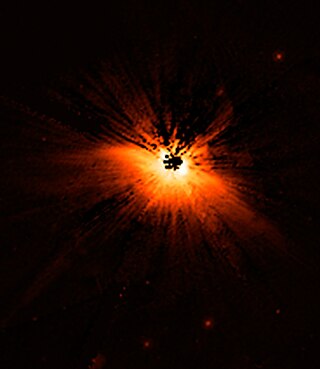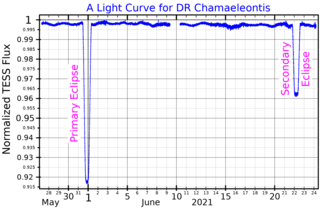HD 101930, also known as Gliese 3683, is an orange hued star with an orbiting exoplanet located in the southern constellation Centaurus. It has an apparent magnitude of 8.21, making it faintly visible in binoculars but not to the naked eye. The system is located relatively close at a distance of 98 light years but is receding with a heliocentric radial velocity of 18.4 km/s. It has a relatively large proper motion, traversing the celestial sphere with an angular velocity of 0.320″·yr−1.
HD 63454, formally named Ceibo, is a star located in the southern circumpolar constellation Chamaeleon near the border with Mensa. To see the star, one needs a small telescope because it has an apparent magnitude of 9.36, which is below the limit for naked eye visibility. The object is located relatively close at a distance of 123 light years based on Gaia DR3 parallax measurements but is receding with a heliocentric radial velocity of 33.8 km/s. At its current distance, HD 63454's brightness is diminished by two tenths of a magnitude due to interstellar dust. It has an absolute magnitude of +6.68.

CT Chamaeleontis (CT Cha) is a T Tauri star - a primary of the star system in the constellation of Chamaeleon. It has an apparent visual magnitude which varies between 12.31 and 12.43. The star is still accreting material at rate 6×10−10 M☉/year.
HD 190984, also known as HIP 99496, is a star located in the southern circumpolar constellation Pavo, the peacock. It has an apparent magnitude of 8.76, making it readily visible in small telescopes, but not to the naked eye. Based on parallax measurements from the Gaia spacecraft, the object is estimated to be 486 light years away from the Solar System. It appears to be receding with a heliocentric radial velocity of 20.3 km/s.

HD 24479, also designated as HR 1204, is a solitary, bluish-white hued star located in the northern circumpolar constellation Camelopardalis. The star is visible to the naked eye with an apparent visual magnitude of 5.04. Based on Gaia DR3 parallax measurements, it is located 385 light years from the Sun. However, it is receding with a somewhat constrained heliocentric radial velocity of 4.6 km/s. At its current distance, HD 24479's brightness is diminished by 0.29 magnitudes due to interstellar dust.

Epsilon Chamaeleontis, Latinized from ε Chamaeleontis, is a triple star located in the southern circumpolar constellation Chamaeleon. The primary and secondary have apparent magnitudes of 5.33 and 6.02, making them visible to the naked eye. Hipparcos parallax measurements place the system at a distance of 360 light years and is currently receding with a heliocentric radial velocity of 13 km/s.
μ1 Chamaeleontis, Latinized as Mu1 Chamaeleontis, is a single star in the southern circumpolar constellation Chamaeleon. It is dimly visible to the naked eye with an apparent visual magnitude of 5.53. Based upon parallax measurements, it is located approximately 403 light-years away from the Sun. The radial velocity is poorly constrained, but it appears to be drifting further away at the rate of about 16 km/s
HD 63399 is an orange hued star located in the southern constellation Puppis, the poop deck. It has an apparent magnitude of 6.45, placing it near the limit for naked eye visibility. Based on parallax measurements from Gaia DR3, the object is estimated to be 445 light years distant. It appears to be receding with a spectroscopic radial velocity of 28.5 km/s. At its current distance, HD 63399 is diminished by 0.29 magnitudes due to interstellar dust.

Beta Microscopii, Latinized from β Microscopii, is a solitary star in the constellation Microscopium. It is close to the lower limit of stars that are visible to the naked eye having an apparent visual magnitude of 6.05 Based upon an annual parallax shift of 6.5022 mas as seen from Earth, this star is located 502 light years away from the Sun. At that distance, the visual magnitude is diminished by an extinction factor of 0.19 due to interstellar dust.

HD 61005, also known as HIP 36948 and The Moth, is a young star located in the southern constellation Puppis, the poop deck. It has an apparent magnitude of 8.22, making it readily visible in binoculars, but not to the naked eye. The object is located relatively close at a distance of 119 light years based on Gaia DR3 parallax measurements but is receding with a heliocentric radial velocity of 22.6 km/s.
HD 96146 is a binary star located in the southern constellation Antlia. The system has a combined apparent magnitude of 5.41, making it visible to the naked eye under ideal conditions. Parallax measurements from the Gaia spacecraft place the pair at a distance of 710 light years with a large margin of error. It is currently receding with a poorly constrained heliocentric radial velocity of 4.7 km/s.
HD 126209, also known as HR 5389, is a solitary, orange hued star located in the southern circumpolar constellation Apus. It has an apparent magnitude of 6.06, making it faintly visible to the naked eye under ideal conditions. Based on parallax measurements from the Gaia spacecraft, the object is estimated to be 560 light years distant. It appears to be approaching the Solar System with a fairly constrained heliocentric radial velocity of −8.1 km/s. De Mederios et al. (2014) found the radial velocity to be variable, making it a probable spectroscopic binary. Eggen (1993) lists it as a member of the old disk population.

HD 26764, also known as HR 1314 or rarely 14 H. Camelopardalis, is a solitary white hued star located in the northern circumpolar constellation Camelopardalis. It has an apparent magnitude of 5.19, making it faintly to the naked eye if viewed under good conditions. Gaia DR3 parallax measurements place the object at a distance of 266 light years and is drifting closer with a poorly constrained heliocentric radial velocity of 3 km/s. At its current distance, HD 26764's brightness is diminished by 0.26 magnitudes due to interstellar dust.

HD 27022, also known as HR 1327, is a star located in the northern circumpolar constellation Camelopardalis. The object has also been designated as 20 H. Camelopardalis, but is not commonly used in modern times. It has an apparent magnitude of 5.27, allowing it to be faintly visible to the naked eye. Based on parallax measurements from Gaia DR3, the star has been estimated to be 347 light years away. It appears to be approaching the Solar System, having a heliocentric radial velocity of −19.5 km/s.

HD 76236, also designated as HR 3543 or rarely 11 G. Chamaeleontis, is a solitary star located in the southern circumpolar constellation Chamaeleon. It is faintly visible to the naked eye as an orange-hued star with an apparent magnitude of 5.77. Based on parallax measurements from the Gaia satellite, the object is estimated to be 612 light years away. Currently, it is receding with a heliocentric radial velocity of 7 km/s. At its current distance, HD 76236's brightness is diminished by 0.39 magnitudes due to interstellar dust. It has an absolute magnitude of −0.13.
HD 58425, also known as HR 2830, is an astrometric binary located in the northern circumpolar constellation Camelopardalis. It is faintly visible to the naked eye as an orang point of light at an apparent magnitude of 5.64. Based on parallax measurements from Gaia DR3, the system is estimated to be 470 light years away from Earth. It appears to be rapidly receding from the Sun, having a heliocentric radial velocity of 58.6 km/s. HD 58425 is listed as 54 Ursae Majoris in Johann Hevelius' catalogue, but this was dropped after the official IAU's official constellation borders were drawn.
HD 31529, also known as HR 1584, is a solitary, orange hued star located in the southern constellation Caelum, the chisel. It has an apparent magnitude of 6.09, making it faintly visible to the naked eye if viewed under ideal conditions. This object is located relatively far at a distance of 932 light years based on parallax measurements from Gaia DR3, but is receding with a heliocentric radial velocity of 28.4 km/s. Eggen (1989) lists it as a member of the old disk population.
HD 32820, also known as HR 1651, is a yellowish-white hued star located in the southern constellation Caelum, the chisel. It has an apparent magnitude of 6.3, placing it near the limit of naked eye visibility. The object is located relatively close at a distance of 103 light years based on parallax measurements from Gaia DR3, but is receding with a heliocentric radial velocity of 29.8 km/s.

DR Chamaeleontis, also known as HD 93237, is a star located in the southern circumpolar constellation Chamaeleon. The system has an average apparent magnitude of 5.97, allowing it to be faintly visible to the naked eye. DR Cha is located relatively far at a distance of 1,060 light years based on Gaia DR3 parallax measurements, but is receding with a poorly constrained heliocentric radial velocity of 18 km/s.

HD 168592, also designated as HR 6862 or rarely 7 G. Coronae Australis, is a solitary star located in the southern constellation Corona Australis. It is faintly visible to the naked eye as an orange-hued star with an apparent magnitude of 5.07. Gaia DR3 parallax measurements place it at a distance of 490 light years and is currently receding with a heliocentric radial velocity of 18 km/s. At its current distance, HD 168592's brightness is diminished by 0.38 magnitudes due to interstellar dust. It has an absolute magnitude of −0.76.







